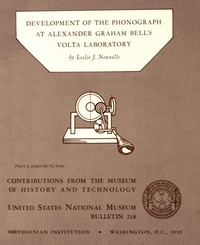Development of the Phonograph at Alexander Graham Bell's Volta Laboratory
"Development of the Phonograph at Alexander Graham Bell's Volta Laboratory" by Leslie J. Newville is a scientific publication written in the mid-20th century. The book explores the innovative work done by Alexander Graham Bell and his associates in developing the phonograph, a pivotal technology in sound recording and reproduction that significantly improved upon Edison's earlier inventions. The narrative provides insights into the collaboration and experiments that took place at Bell's Volta Laboratory,
highlighting the technological advancements made and the eventual commercialization of these groundbreaking inventions. The content of the book chronicles the establishment of the Volta Laboratory Association and the key figures involved, including Charles Sumner Tainter and Chichester Bell. It details the challenges and experiments the team faced in transforming Edison's tinfoil-based phonograph into a more efficient wax recording device. The text covers their early designs and experiments with various forms of sound recording, including disc and cylinder types, leading to the filing of critical patents in 1886. Newville provides a historical context for these developments, examining not just the inventions themselves but also the social and economic factors that influenced their success. Ultimately, the book illustrates how the work done at the Volta Laboratory laid foundational principles that contributed to the modern sound recording industry. (This is an automatically generated summary.)
Read or download for free
| How to read | Url | Size | |||
|---|---|---|---|---|---|
| Read now! | https://www.gutenberg.org/ebooks/30112.html.images | 59 kB | |||
| EPUB3 (E-readers incl. Send-to-Kindle) | https://www.gutenberg.org/ebooks/30112.epub3.images | 496 kB | |||
| EPUB (older E-readers) | https://www.gutenberg.org/ebooks/30112.epub.images | 494 kB | |||
| EPUB (no images, older E-readers) | https://www.gutenberg.org/ebooks/30112.epub.noimages | 82 kB | |||
| Kindle | https://www.gutenberg.org/ebooks/30112.kf8.images | 530 kB | |||
| older Kindles | https://www.gutenberg.org/ebooks/30112.kindle.images | 521 kB | |||
| Plain Text UTF-8 | https://www.gutenberg.org/ebooks/30112.txt.utf-8 | 47 kB | |||
| Download HTML (zip) | https://www.gutenberg.org/cache/epub/30112/pg30112-h.zip | 486 kB | |||
| There may be more files related to this item. | |||||
Similar Books
About this eBook
| Author | Newville, Leslie J. |
|---|---|
| Title |
Development of the Phonograph at Alexander Graham Bell's Volta Laboratory Contributions from the Museum of History and Technology, United States National Museum Bulletin 218, Paper 5, (pages 69-79) |
| Note | Reading ease score: 64.1 (8th & 9th grade). Neither easy nor difficult to read. |
| Credits | E-text prepared by Chris Curnow, Joseph Cooper, Stephanie Eason, |
| Language | English |
| LoC Class | Q: Science |
| Subject | Phonograph |
| Category | Text |
| EBook-No. | 30112 |
| Release Date | Sep 27, 2009 |
| Copyright Status | Public domain in the USA. |
| Downloads | 351 downloads in the last 30 days. |
| Project Gutenberg eBooks are always free! | |


